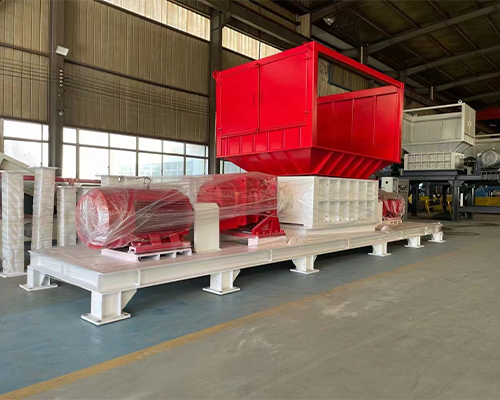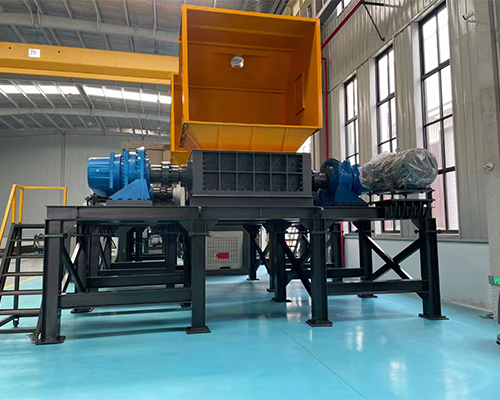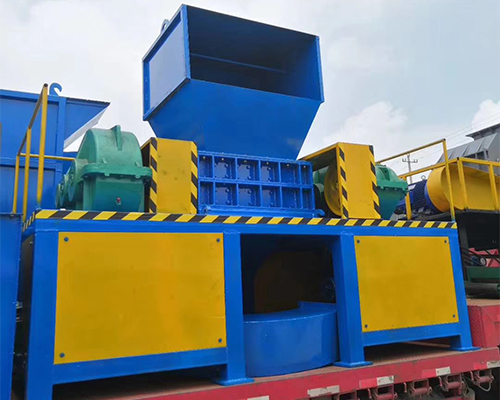Dual-Shaft Shredder: An Efficient and Versatile Waste Management Solution
Dual-Shaft Shredder: An Efficient and Versatile Waste Management Solution
A dual-shaft shredder is a heavy-duty machine widely used in waste processing and material recycling. Unlike single-shaft shredders, dual-shaft shredders are equipped with two interlocking shafts that rotate in opposite directions, providing exceptional shredding power and efficiency. This design allows the machine to handle a wide range of materials, making it an indispensable tool in various industries, including recycling, manufacturing, and waste management.

Key Features of Dual-Shaft Shredders
Dual-Shaft Design: The most defining feature of a dual-shaft shredder is its two independent shafts. These shafts are fitted with sharp, hardened steel blades or knives that rotate in opposite directions. As the material enters the shredder, it is torn, pulled, and fragmented by the rotating shafts, ensuring an even and controlled shredding process.
Heavy Duty Construction: Dual-shaft shredders are built to withstand heavy loads and intense operational conditions. They are typically made from high-quality materials such as steel and are designed to handle tough, industrial-grade materials like metal, rubber, plastics, and electronic waste.
Versatility: Dual-shaft shredders are incredibly versatile machines, capable of shredding a wide array of materials. These include bulky items, hazardous waste, tires, plastics, wood, paper, and electronic waste. The machine’s shredding capacity can be customized according to the type and size of material being processed, making it suitable for a wide range of applications.
Safety Features: Many dual-shaft shredders come with safety features such as emergency stop buttons, overload protection, and a robust enclosure to prevent accidents. These safety measures ensure that the machine operates efficiently while protecting operators from potential harm.

Applications of Dual-Shaft Shredders
Recycling: One of the primary uses of dual-shaft shredders is in recycling. These machines are highly effective in breaking down waste materials into smaller, manageable pieces that can be further processed and reused. Whether it’s shredding plastic bottles, cardboard, or electronic scrap, dual-shaft shredders play a crucial role in the recycling industry.
Waste Management: In waste management, dual-shaft shredders are used to reduce the size of various waste materials before they are disposed of or sent to landfills. By shredding materials into smaller particles, the shredder increases the efficiency of waste sorting, compaction, and transport, ultimately reducing the environmental footprint.
Plastic and Rubber Shredding: The ability of dual-shaft shredders to handle tough, elastic materials like plastic and rubber makes them ideal for recycling plastic containers, rubber tires, and other synthetic materials. This is crucial in reducing landfill waste and promoting the recycling of non-biodegradable materials.
Metal Recycling: Dual-shaft shredders are also used to process scrap metal. Their powerful blades can easily break down metal objects, such as car parts and metal sheets, into smaller fragments that can be melted down and reused. This is an essential process in the automotive, construction, and manufacturing industries.
Electronic Waste (E-Waste): E-waste recycling is another important application of dual-shaft shredders. With the rise of electronic devices, there is a growing need for efficient e-waste management. These shredders are capable of breaking down old electronics like computers, phones, and televisions, making it easier to recover valuable metals like gold, copper, and aluminum.

Advantages of Dual-Shaft Shredders
High Shredding Efficiency: Dual-shaft shredders provide high throughput rates and can process large volumes of material in a relatively short time. The dual-shaft mechanism ensures that materials are consistently and uniformly shredded, optimizing operational efficiency.
Reduced Maintenance: Due to their robust design and durable components, dual-shaft shredders require minimal maintenance. The design is often modular, making it easier to replace individual parts without having to replace the entire machine.
Lower Power Consumption: Dual-shaft shredders are often more energy-efficient compared to single-shaft models. The power distribution across two shafts reduces the strain on individual components, improving the overall energy efficiency of the machine.
Customizable Output Size: The output size of the shredded material can be adjusted by changing the blade configuration or adjusting the speed of the shafts. This flexibility allows users to customize the shredded material according to their specific needs.
Conclusion
Dual-shaft shredders are an invaluable tool for industries focused on waste reduction, recycling, and material processing. Their robust construction, powerful shredding ability, and versatility make them ideal for handling a variety of materials, from metals and plastics to rubber and e-waste. As industries continue to push for more sustainable practices and efficient waste management solutions, dual-shaft shredders will undoubtedly remain an essential part of the waste management and recycling ecosystem. With their high efficiency, low maintenance requirements, and customizable features, dual-shaft shredders are poised to play a key role in shaping the future of waste processing and recycling technologies.
| Model | 600 | 800 | 1000 | 1200 | 1400 | 1600 | 1800 |
| Motor(kw) | 11*2 | 18.5*2 | 35*2 | 45*2 | 55*2 | 75*2 | 110*2 |
Reducer | P6-P7 | P7-P8 | P8-P10 | P10-P12 | P11-P13 | P12-P16 | P14-P16 |
| Siemens or other motors, planetary reducers or other reducers can be customized according to customer requirements | |||||||
| Rotation Speed | 8-20rmp | 8-20rmp | 8-15rmp | 8-15rmp | 8-15rmp | 8-12rmp | 8-12rmp |
| Blades Diameter | 220-320 | 260-320 | 260-400 | 400-500 | 400-500 | 500 | 500 |
| Blades material | The material of the blades (55sicr, 5crsi, 9crsi, skd11, m6v, h13) can be customizedaccording to the customer's actual usage | ||||||
| Feeding Size | 1200*900mm | 1400*1000mm | 1600*1200mm | 1800*1300mm | 2000*1300mm | 2200*1700mm | 2400*2000mm |
| The size and appearance of the feeding hopper can be customized according to thecustomer's feeding situation | |||||||
| Weight(kg) | 1800 | 2500 | 3700 | 5500 | 7500 | 9500 | 13000 |
-
 Trommel screenTrommel screen, also known as drum screens, are widely used in various industries for sorting and separating materials.Get Quote
Trommel screenTrommel screen, also known as drum screens, are widely used in various industries for sorting and separating materials.Get Quote -
 Crop straw double shaft shreddApplications:Biomass Energy Production: Shredded straw can be used as a feedstock for bioenergy plants to produce electricity or heat.Livestock Feed: Reduced-si...Get Quote
Crop straw double shaft shreddApplications:Biomass Energy Production: Shredded straw can be used as a feedstock for bioenergy plants to produce electricity or heat.Livestock Feed: Reduced-si...Get Quote -
 Zhongcheng Air Drum SeparatorAir drum separators effectively separate lightweight materials (e.g., plastics, paper) from heavier materials (e.g., metals, glass). This high efficiency is cru...Get Quote
Zhongcheng Air Drum SeparatorAir drum separators effectively separate lightweight materials (e.g., plastics, paper) from heavier materials (e.g., metals, glass). This high efficiency is cru...Get Quote
-
2024-05-18Hydraulic Cone CrusherHydraulic Cone Crusher integrates machinery, hydraulic pressure, electrics, automation, and intelligent control, which can be used for medium crushing, fine cru...
-
2023-01-13Bag OpenerBag opener or bag opener system is a mechanical device used to automatically open and empty bags containing bulk materials. This system is commonly used in indu...
-
2024-08-07Tire double shaft shredderOperation:Feeding: Whole or pre-cut tires are fed into the shredder through an inlet hopper.Shredding: As the tires enter the shredding chamber, the rotating cu...
-
2024-07-12Crush to Create: The Ultimate Eco-Friendly Plastic Shredder RevolutionThe working principle of a plastic shredder is mainly to tear large plastic materials into small pieces or fragments through mechanical force, in order to facil...
-
2024-06-11Optimize Your Waste Management Today with Our Advanced Drum ScreensUnderstanding the Mechanism and Optimization of Drum Screens for Waste Management



